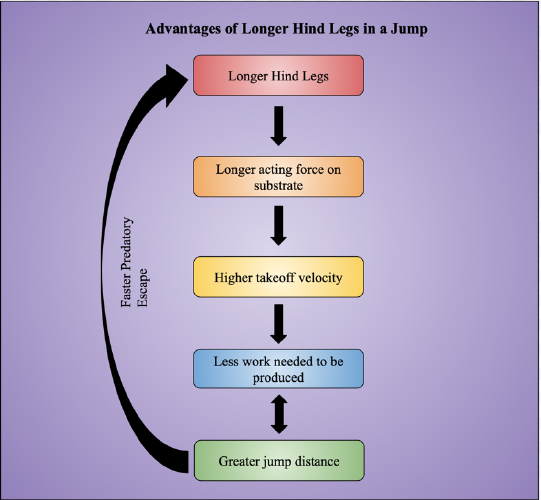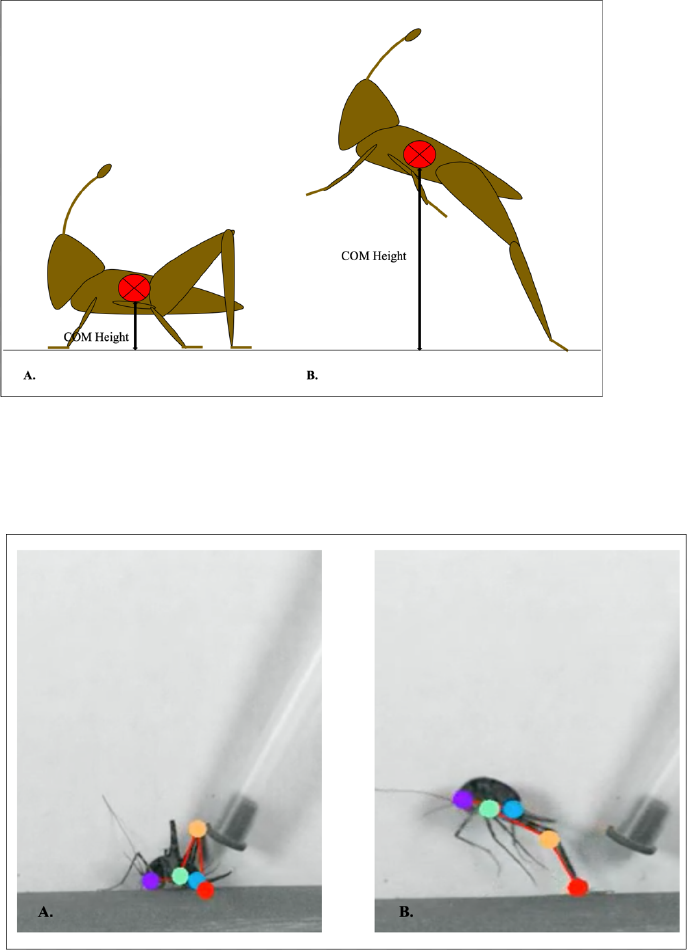
Longwood University Longwood University
Digital Commons @ Longwood University Digital Commons @ Longwood University
Longwood Senior Thesis Proposal O8ce of Student Research
Spring 4-17-2023
Biomechanics Locomotion and Predation Escape in Cricket Biomechanics Locomotion and Predation Escape in Cricket
Species Species
Kira M. Edens
Longwood University
Follow this and additional works at: https://digitalcommons.longwood.edu/senior_thesis_proposals
Part of the Integrative Biology Commons
Recommended Citation Recommended Citation
Edens, Kira M., "Biomechanics Locomotion and Predation Escape in Cricket Species" (2023).
Longwood
Senior Thesis Proposal
. 2.
https://digitalcommons.longwood.edu/senior_thesis_proposals/2
This Proposal is brought to you for free and open access by the O8ce of Student Research at Digital Commons @
Longwood University. It has been accepted for inclusion in Longwood Senior Thesis Proposal by an authorized
administrator of Digital Commons @ Longwood University. For more information, please contact

1
Biomechanical Locomotion and Predation Escape in Cricket Species
Applicant: Kira M. Edens ‘24
Farmville, VA 23901
Phone: 804-920-7309
Email: [email protected]
Faculty Mentor: Brandon E. Jackson, Ph.D.
Chichester Science Center, Room 305a
Department of Biological and Environmental Sciences
Longwood University
Farmville, VA 23909
Phone: 434-395-4836
Email: [email protected]
Discipline: Biology: Integrative Biology
Date of Submission: April 17, 2023
__________________________________ ___________
Kira M. Edens (Applicant) Date
__________________________________ ___________
Brandon E. Jackson, Ph.D. (Faculty Sponsor) Date
4/17/2023
4/17/2023
2
Biomechanical Locomotion and Predation Escape in Cricket Species
I. Statement of Guiding Hypotheses
Locomotion is a fundamental to everyday life and ultimate survival of almost all living
animals through its role in capturing food, escaping predators, defense, finding a mate, and
discovering new habitats. Researchers have studied all different components of locomotion, from
flying to swimming and from running to jumping. These studies range drastically in numerous
organism species, specifically jumping performance in vertebrate and invertebrate animals and
insects. In the two semesters I have worked in Dr. Jackson’s lab, we have been surprised that
researchers have studied very little about the biomechanics behind a crickets jump. The few
studies worked with only one species of crickets to analyze the acceleration, power, velocity, and
work put out by the jumping performance. We have not found a single comparative study of
jumping techniques and mechanics among multiple cricket species which would show how their
morphology and physiology differ between jumps. Very few studies have been done on any
organism to examine how locomotor performance directly affects important behaviors like
escaping from predators.
This semester, Dr. Jackson and I set out a goal to film and track the locomotion of camel
crickets (Rhaphidophoridae Orthoptera) using the coding software Python and a tracking
software DeepLabCut. What we observed is that this cricket species has larger body and leg
lengths than other crickets. Cave Crickets (Rhaphidophoridae Orthoptera) have longer, more
slender legs than most other species (i.e. field crickets, Gryllinae Orthoptera). Biomechanical
theory says that longer legs should mean more time for force to be applied to the ground, which
can lead to higher energy and power exerted in a jump. Perhaps the different leg lengths could
aid them when jumping in predatorial escape compared to a shorter body and leg lengths. For
3
this Senior Thesis Research, I aim to investigate how longer body and leg lengths on crickets
jumping performance, both within and between two species of crickets, and how that jumping
performance affects actual predator escape. Thus, I hypothesis that cave crickets, with their
longer legs, will have a better jump performance than other species, and will have a higher
likelihood of escaping from predators.
II. Research Significance
There have been numerous prior studies involving crickets and insect jumps where
researchers observe different jumping and leg performance between multiple species from
humans to locust and jumping froghoppers to stinging jellyfish (e.g., Alexander, R, McN, 1995;
Patek, S. N., et al., 2022). Other researchers have specifically looked at ballistic movements of
jumping performance and the tasks of specialized appendages (e.g., Hustert, R. and Baldus, M.,
2010). Although there’s been little research pertaining jump performance of species between one
organism, crickets have specialized morphologies for jumping and are diverse, which would
make them an ideal model system for investigating how selected forces on jumping lead to the
diversity of extant crickets. Previous studies state that length of hind legs and body weight tend
to play a big role in locomotion of millimeter-to-centimeter sized insects, for the inertia force
that is depicted in jump performance is dependent on the weight and volume of the body (Li, F.
et al., 2012). The hind legs of an invertebrate major importance to jump performance, for when
hind legs extend and used as a propulsion for the muscles, generating a constant higher velocity
relative to the center of mass while producing low strain-rate that increases energy produced in a
jump (Alexander, R, McN, 1995)(Figure 2). In our lab we have already done preliminary data
that depicts the way crickets prepare for a jump. The crickets tend to move most of their body
when starting a jump performance where they tuck in their head and abdomen and tuck their hind
4
legs in to where the knees point outwards, so that the crickets create that power when extending
their hind legs (Figure 1). Studies have been done on female versus male body size of a
planthopper, and the females with a larger body size had a longer acceleration time and velocity
than males by a significant amount in both tests(Burrows, M., 2009).
When studying a close insect to crickets, researchers have discovered that bred and stress
induced grasshoppers have a takeoff velocity 1-2 times faster and 2-6 times longer jump
distances than wild grasshoppers due to morphological changes of matured grasshoppers and
unmatured grasshoppers (Hawlena, D., 2011). When observing crickets such as bush crickets
researchers found that female bush crickets’ hind leg femur length equivalates to four times that
of male bush crickets which contributed to a higher take-off velocity in females of
2.12±0.33ms
-1
while in males resulted in a lower take-off velocity of 1.51±0.2ms
-1
(Burrows, M.
and Morris, O., 2003). The extension of the hind legs is fascinating to researchers, for how much
height it brings to the center of mass to the cricket and how morphological differences in hind
leg length aid in jumping performance (Figure 2).
Researchers have also done many studies involving prey and predator interactions by
studying behavioral tactics producing in prey. For this study, we hope to determine how
differences in jumping performance is affected with body and length size of different cricket
species and predation escape (Figure 4). Previous studies of predation escape have shown that
crickets have sensor hairs that will alert them based on wind and a predator is close by,
researchers performed this by using airflow stimuli that could aid them in predatory escape
(Tauber, E and Camhi, J. M., 1995; Sato, N. et al. 2019). Our research and previous research
think that once stimuli happen, depending on morphological benefits such as longer legs would
aid the cricket in predatory escape, for longer hind legs result in a longer jump (Burrows, M. and

5
Picker, M. D., 2010)(Figure 1). For the second part of this research we aim to use lizards as a
predatory stimulant for the predatory-prey interactions. Research has been done on Varanid
lizards and their consumption rate of different species of prey, researchers elaborated that most
invertebrates and especially Orthoptera species are critical for a lizard diet due to habitation and
attraction (Cross, S. L. et al., 2020). This is important to our study, for the predation escape of
crickets will be more frequent and show differential data in the number of crickets remaining if a
predator that consumes invertebrates on a daily is used in this study. This project aims to be the
first study that we know of to directly attempt to link comparative cricket morphology, jumping
performance, and survival.
As described above, the findings of this project will be one of the first studies reported about
cricket species and the effect of body size and leg length have on jump performance and predator
escape. While our preliminary work on six camel crickets suggests that there is no effect of leg
length on jumping performance within the species, we do expect to find an effect when
comparing among species. In addition to other research done in the past on cricket jump
performance, we anticipate that other researchers could use this information to help determine
other insect or vertebrates jump performance between species – even if they are not studying
crickets.
III. Proposed Methodology
Animals and Animal Care
A collection camel crickets (Rhaphidophoridae Orthoptera), and field crickets (Gryllinae
Orthoptera) will be collected outside of the Environmental Education Center using a live insect
trap. Crickets will be housed in separate plastic containers depending on species and labeled.

6
Crickets will be provided access to food (fruits, vegetables, and grass), tap water, cardboard for
enrichment, air holes, and a humidity sensor.
A total of six mature unisex Anole lizards (Anolis carolinensis) (Carolina Biological
Supply Company) will be singly housed in singular 10 gallon (12”x12”x18”) glass terrariums
with potting soil as bedding. Lizards will be provided with food (Carolina Biological Supply
Company), plants and sticks for enrichment, tap water and misting daily, and a low-wattage
heating lamp to keep temperature at 24° C to 27° C with a warmer basking area that reaches
29.5° C to 33° C.
Jumping Performance Collection
A built glass arena lined with sandpaper will be used to hold crickets when filming
jumping performance. A high-speed camera (Edgertronic, Frame Rate: 500Frames/Second) and
LED lights was used to film crickets. Crickets will be individually placed in area and stimulated
to jump by air puffs from a disposable pipet to get about 10-20 jumps every week for three
hours. Once crickets are filmed with enough jumps they will be euthanized and preserved in 70%
ethanol.
Jumping Performance Tracking and Analysis
Each video will be tracked using DeepLabCut (Mathis, A. et al., 2018). The tracking
software will be trained using a video of previously filmed cricket videos by hand-labeling points
of the body: head, abrear (lower abdomen), hip, knee, and claw. The rest of the videos were
tracked using the trained tracking software (DeepLabCut). The preliminary filming and computer
model training has already been completed. The videos will then analyzed by the used of
calibration to provide femur length, tibia length, body length, jump start frame, jump end frame,
jump time, jump velocity, jump angle, jump height, jump power, mass specific jump power, and

7
relative mass. The data will be saved into an Excel file and then Excel was used to convert each
trial data from pixels to centimeters. Excel will be used to create acceleration, work, potential
energy, and kinetic energy from the data given.
Predator-Prey Interaction and Analysis
Crickets that will not be filmed for jumping performance will be used for predator-prey
interaction. A total of 24 crickets, four crickets per Anole lizard, will placed into each anole
lizard habitat container and left for 30 minutes. Two camel crickets (Rhaphidophoridae
Orthoptera) and two field crickets (Gryllinae Orthoptera) will be placed in each habitat. After
30 minutes, each habitat will be analyzed and recorded by counting how many crickets are still
alive to create a percent of crickets remaining (Figure 4). The crickets remaining were then
placed back into their normal habitat. This interaction was recorded another 4 times.
IV. Resources and Locations
a. Key Resources
i. Cricket housing facility, food, and water
ii. Lizard housing facility, food, and water
iii. Calibers
iv. Preservative fluids (70% ethanol)
v. Data analysis software
vi. High speed camera (Edgergonics)
vii. LED lights
b. Locations

8
i. All of the camera and recording resources required for this
experiment are located in Dr. Jackson’s research laboratory
Chichester 217
ii. Software programs such as Python, Excel, DeepLabCut, and
specialized computer to run the auto-tracking, are available in Dr.
Jackson’s Computer Image Analysis lab (Chichester 219)
V. Timeline for Completion
Summer 2022-Spring 2023
• Learn laboratory techniques/skills, including:
a. Digitizing video
b. Filming techniques
c. Programing (Python)
d. Built filming arena
e. Trained computer model to track cricket
• Collection of data for crickets
a. Filming
b. Statistical data analysis
c. Tracking via DeepLabCut and Python
Summer 2023
• Literature collection
• Analysis of preliminary data
Fall 2023
• Collection of cricket species at Environmental Education Center

9
• Build prey-predator filming arena
• Filming
a. Cricket species
• Tracking via DeepLabCut and Python
• Initial draft of LST paper, including analysis of preliminary data to Dr. Jackson by Spring
Break
• Presentation of preliminary data
Spring 2024
• Data Analysis
• Writing of Senior Thesis
• Final Senior Thesis submitted to Dr. Jackson
• Oral Defense Preparation
VI. Anticipated Committee Members
Brandon E. Jackson, Ph.D. Associate Professor of Biology, Longwood University
Charles D. Ross, Ph.D. Associate Professor of Physics, Longwood University
Andrew M. Mountcastle Ph.D. Associate Professor of Biology, Bates College
VII. Approval by the Department Chair (sent via email)
VIII. LITERATURE CITED
1. Alexander, R. McN. (1995). Leg design and jumping technique for humans, other
vertebrates and insects. Philosophical Transactions: Biological Sciences 347(1321):235–
48.
2. Burrows, M. (2009). Jumping performance of planthoppers (Hemiptera, Issidae). Journal
of Experimental Biology 212(17):2844–55.
3. Burrows, M. and Morris, O. (2003). Jumping and kicking in bush crickets. Journal of
Experimental Biology 206(6):1035–49.
4. Burrows, M. and Picker, M. (2010). Jumping mechanisms and performance of pygmy
mole crickets (Orthoptera, Tridactylidae). The Journal of Experimental Biology
213:2386–98.

10
5. Cross, S. L., Craig, M. D., Tomlinson, S., & Bateman, P. W. (2020). I don’t like crickets,
I love them: Invertebrates are an important Prey Source for Varanid lizards. Journal of
Zoology 310(4):323–33.
6. Hawlena, D., Kress, H., Dufresne, E.R., & Schmitz, O. J. (2011). Grasshoppers alter
jumping biomechanics to enhance escape performance under chronic risk of spider
predation. Functional Ecology 25(1):279–88.
7. Hustert, R. and Baldus, M. (2010). Ballistic movements of jumping legs implemented as
variable components of cricket behaviour. Journal of Experimental Biology
214(12):18112.
8. Li, F., Lin W., Fu, X., Bonsignori, G., Scarfogliero U., Stefanini C., & Dario P. (2012).
Jumping like an insect: design and dynamic optimization of a jumping mini robot based
on bio-mimetic inspiration. Mechatronics 22(2):167–76.
9. Mathis, A., Mamidanna, P., Cury, K. M., Abe, T., Murthy V. N., Mathis, M. W., &
Bethge, M. (2018). DeepLabCut: markerless pose estimation of user-defined body parts
with deep learning. Nature Neuroscience 21(9):1281–89.
10. Patek, S. N., Dudek, D. M., & Rosario, M. V. (2011). From bouncy legs to poisoned
arrows: elastic movements in invertebrates. Journal of Experimental Biology
214(12):1973–80.
11. Sato, N., Shidara, H., & Ogawa, H. (2019). Trade-off between motor performance and
behavioural flexibility in the action selection of cricket escape behaviour. Scientific
Reports 9(1):18112.
12. Tauber, E., and Camhi, J. (1995). The wind-evoked escape behavior of the cricket
Gryllus Bimaculatus : integration of behavioral elements. The Journal of Experimental
Biology 198:1895–1907.
IX. FIGURES

11
Figure 1. Advantages of having longer hind legs for jumping performance. Long hind legs
result in a longer acting force on substrate, which then results in a higher takeoff velocity and
a greater jump distance produces more work in a jump that aids a prey for a faster predatory
escape.
Figure 2. Basic layout of cricket leg extension. (A) depicts a cricket’s hind leg at resting
point a lower COM. (B) depicts a cricket’s hind leg at full extension a higher COM.
Figure 3. Preliminary tracked data from DeepLabCut of camel cricket jump performance in
lab. Colored dots include: purple (Head), green (Hip), blue (Abrear or lower abdomen),

12
orange (Knee), and red (Claw). (A) depicting the stance in which the cricket is preparing for a
jump by bring the head and abdomen inwards and pointing hind legs outwards. (B) depicting
the extension of the hind legs at the jump end frame.
Figure 4. Hypothesis of what is predicted that might happen with the percentages of
remaining crickets after predator-prey interaction trials. This is based on the leg lengths of
cave crickets and advantages of higher take off velocity and greater distances to escape
predators.
FIELD CRICKETS CAVE CRICKETS
% REMAINING
HYPOTHESIS OF CRICKETS
REMAINING AFTER PREDATION
